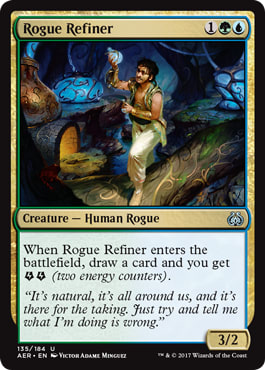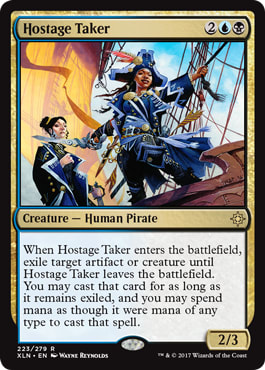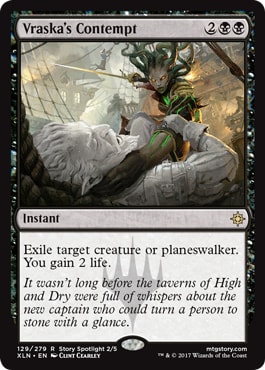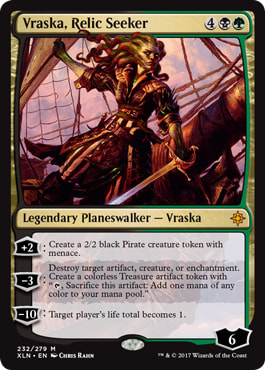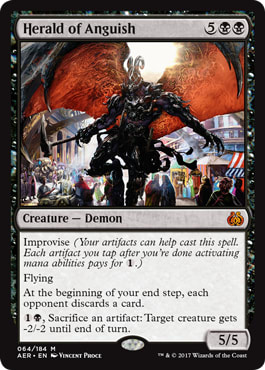The first weekend of Ixalan Standard has come and gone, bringing with it some results that indicate this will be an energized Standard format. While Temur Energy was the predicted best Energy archetype after the results it had in the previous season, it was actually a different three color Energy deck that came out on top in Dallas:
Sultai Energy ? Ixalan Standard | Andrew Jessup
- Creatures (27)
- 1 The Scarab God
- 2 Rishkar, Peema Renegade
- 4 Glint-Sleeve Siphoner
- 4 Hostage Taker
- 4 Longtusk Cub
- 4 Rogue Refiner
- 4 Walking Ballista
- 4 Winding Constrictor
- Instants (8)
- 4 Blossoming Defense
- 4 Fatal Push
- Sorceries (4)
- 4 Attune with Aether
- Lands (21)
- 1 Island
- 2 Swamp
- 4 Forest
- 2 Fetid Pools
- 4 Aether Hub
- 4 Blooming Marsh
- 4 Botanical Sanctum
- Sideboard (15)
- 4 Deathgorge Scavenger
- 2 Negate
- 1 Spell Pierce
- 2 Vraska's Contempt
- 1 The Scarab God
- 1 Vraska, Relic Seeker
- 4 Duress
This deck is very similar to the ![]()
![]() Winding Constrictor decks we saw last season, but with a few powerful Blue cards splashed in:
Winding Constrictor decks we saw last season, but with a few powerful Blue cards splashed in:
Rogue Refiner is easily one of the most powerful cards in the current Standard format. While it does not do anything flashy, it puts a reasonable body into play that immediately replaces itself with a card draw, while also producing energy for our other cards to utilize.
Hostage Taker might be up for the title of most powerful card to come out of Ixalan so far. In addition to generating a good deal of tempo by taking a creature away from our opponent, Hostage Taker also generates card advantage in the late game as well. It allows the Energy deck to give up powerful removal like Harnessed Lightning, while still having answers to powerful threats our opponent could play.
Speaking of powerful threats, The Scarab God is likely the best creature in Standard. Not only is a 5/5 for five that comes back when it dies potent, but essentially any time you untap with The Scarab God in a creature mirror you are instantly ahead. You get to stop playing cards out from your hand and simply activate The Scarab God over and over again to keep adding pressure to the table.
The rest of the main deck is fairly “stock” ![]()
![]() Energy based on what we saw last season with staples such as Winding Constrictor, Longtusk Cub, Walking Ballista, and Glint-Sleeve Siphoner.
Energy based on what we saw last season with staples such as Winding Constrictor, Longtusk Cub, Walking Ballista, and Glint-Sleeve Siphoner.
As we move to the sideboard we find a couple more Ixalan cards lurking:
Deathgorge Scavenger is a card I like a lot in the current Standard format. Against aggressive decks, it can buffer our life total, against decks looking to abuse the graveyard it acts as targeted hate, and against Torrential Gearhulk decks it can narrow their choices of cards to flash back.
Vraska's Contempt is a card that is more powerful than it first appears. While it screams “expensive Hero's Downfall” at first glance, the fact that Contempt exiles the target is exceedingly relevant against opposing cards like The Scarab God. Vraska, Relic Seeker is simply a “fun of”, but she seems like a reasonable card to pressure midrange and generate value against other control decks. Because The Scarab God is legendary it makes sense to play the first copy of Vraska over the third God.
It comes as no surprise to me that this deck won the open in Dallas after having spent some time playing with it. It is playing efficient threats, while also doing some objectively powerful things. If you are unsure where to start and are simply looking to play the best of the known decks in this format, currently this Sultai Energy deck is the best place for you to be starting.
That being said — Magic is about more than just playing efficient creatures on curve. Doing sweet things is far more fun and boy were there some sweet things to be found in the Dallas results. The next thing I would like to take a look at is a combo deck that is also looking to leverage the power of Hostage Taker:
Esper Gift ? Ixalan Standard | Brennan DeCandio
- Creatures (26)
- 2 Vona, Butcher of Magan
- 4 Angel of Invention
- 4 Champion of Wits
- 4 Hostage Taker
- 4 Minister of Inquiries
- 4 Seekers' Squire
- 4 Walking Ballista
- Instants (3)
- 3 Fatal Push
- Sorceries (2)
- 2 Chart a Course
- Artifacts (6)
- 2 God-Pharaoh's Gift
- 4 Gate to the Afterlife
- Lands (23)
- 3 Swamp
- 6 Island
- 1 Fetid Pools
- 1 Glacial Fortress
- 4 Aether Hub
- 4 Concealed Courtyard
- 4 Drowned Catacomb
- Sideboard (15)
- 2 Cataclysmic Gearhulk
- 1 Fatal Push
- 3 Negate
- 3 Vraska's Contempt
- 2 The Scarab God
- 4 Duress
This deck looks to fill the graveyard up with creatures as quickly as possible with cards like Minister of Inquiries, Seekers' Squire, and Champion of Wits. Once it reaches six or more creatures in the discard pile Gate to the Afterlife can fetch up God-Pharaoh's Gift. God-Pharaoh's Gift allows us to bring cards like Angel of Invention and Vona, Butcher of Magan into play to start creating massive life swings every turn.
While this deck is certainly doing things that are objectively powerful, it felt fairly clunky in the games that I have played with it so far. There are games where we have the wrong colors of mana or have too many Aether Hubs and not enough energy. There are games where we never find our copies of Gate or Gift and just kind of flail around with awkward cards that fill our graveyard. Finally — there are games where we have everything going on that we want to be doing and they simply have a main deck copy of Abrade to destroy our God-Pharaoh's Gift.
While I think this deck is doing interesting things, I do not think it is something I would want to register at a competitive event any time soon. On top of the main deck failure rate, the fact that the winning Sultai Energy list had four copies of Deathgorge Scavenger in the sideboard makes the post board games even more difficult than Game 1.
Thankfully the God-Pharaoh's Gift deck was not the only interesting thing to pop up in Dallas. While folks were busy battling it out in the open, the seven round Standard classic was won by Zac Elsik with an interesting Grixis midrange deck featuring Tezzeret the Schemer:
Grixis Tezzeret ? Ixalan Standard | Zac Elsik
- Creatures (14)
- 1 The Scarab God
- 2 Pia Nalaar
- 3 Contraband Kingpin
- 4 Herald of Anguish
- 4 Maverick Thopterist
- Planeswalkers (3)
- 3 Tezzeret the Schemer
- Instants (8)
- 4 Fatal Push
- 4 Metallic Rebuke
- Artifacts (14)
- 1 Aethersphere Harvester
- 1 Servo Schematic
- 1 Sorcerous Spyglass
- 3 Cogworker's Puzzleknot
- 4 Prophetic Prism
- 4 Renegade Map
- Lands (21)
- 1 Island
- 1 Mountain
- 3 Swamp
- 1 Dragonskull Summit
- 1 Inventors' Fair
- 3 Drowned Catacomb
- 3 Fetid Pools
- 4 Spire of Industry
- 4 Spirebluff Canal
- Sideboard (15)
- 1 Aethersphere Harvester
- 1 Sorcerous Spyglass
- 3 Scrapheap Scrounger
- 3 Tezzeret's Touch
- 4 Negate
- 3 Battle at the Bridge
Thanks to Spire of Industry and Prophetic Prism the first thing I noticed playing this Grixis deck was that the mana was much more consistent. Thanks to cards like Contraband Kingpin and the Servos generated from Cogworker's Puzzleknot, this deck feels like it has a surprisingly good Red matchup. Metallic Rebuke was also a particularly powerful card in this deck. Mana Leak is a card that is likely too powerful to ever be reprinted verbatim in Standard; and, in many situations, Metallic Rebuke felt like Mana Leak plus, being cast for only a single mana.
That being said, it felt like the overall payoff I was getting for playing all these artifacts was not worthwhile. While Maverick Thopterist is fine in Limited, it leaves a bit to be desired in a Constructed format. Tezzeret’s saving grace is that he has a high starting loyalty, but the fact that he has a hard time generating card advantage is disappointing. While his minus occasionally kills something, his plus is fairly mediocre. Often, Tezzeret does not have a meaningful impact on the board when played on turn four which felt pretty bad.
With all of this in mind, there was one thing that consistently impressed me with this Grixis deck:
Most of the games I was winning were on the back of Herald of Anguish. Not only was Herald’s end of turn trigger generating a card advantage for us, but his ability to act as removal and stabilize smaller boards was very powerful. This is definitely a card I want to keep in mind when working on new deck ideas moving forward in the format. It is a fantastic payoff if we can find something to play that happens to play a good deal of artifacts anyways.
Wrapping Up
It is fairly unsurprising that the Energy based aggressive decks had such a good showing this weekend. They had fairly obvious shells that ported over from before rotation and it was fairly easy to identify which new cards should slot nicely into them. While the new decks that are popping up certainly feel rough in their current forms this is to be expected. Tier one decks are not built overnight and very rarely do they appear as early as the first events of a new format.
If I had an event tomorrow that I really wanted to win, I would likely play the main deck of the Sultai Energy deck that won the Dallas open with minor changes to the sideboard. That being said, I am rarely content to just sit and play whatever the best thing is. Herald of Anguish is heading toward the top of my list of cards I want to brew around this season and I am excited to see what else I can come up with for it.
What do you think about the results from the first weekend of Ixalan Standard? Do you think there is a sweet Herald of Anguish hiding in this format somewhere or is the support just not there? Let me know in a comment below!
Cheers,
—Jeff Hoogland













